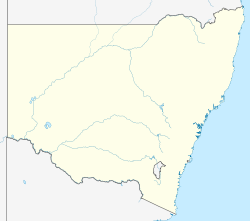Cronulla Beach | |
|---|---|
Beach | |
 View of Cronulla Beach, looking south | |
| Coordinates: 34°03′20″S151°09′18″E / 34.05556°S 151.15500°E | |
| Location | Cronulla, Sydney, New South Wales, Australia |
| Dimensions | |
| • Length | 200 m (219 yards) |
| Patrolled by | Cronulla Surf Life Saving Club |
| Hazard rating | 3/10 (least hazardous) |
| Access | |
Cronulla Beach [1] (sometimes referred to as South Cronulla Beach), is a patrolled beach on Bate Bay in the Sydney suburb of Cronulla, New South Wales, Australia. The Cronulla Pavilion and the Cronulla Lifesaving Club are two prominent buildings located close to the sand. Cronulla Park sits behind the beach. The Cronulla Rock Pools are between Cronulla Beach and North Cronulla beach. The Alley is the local name given to the area between Cronulla Beach and North Cronulla Beach. Shark Island is a dangerous reef break, located off Cronulla Beach.






